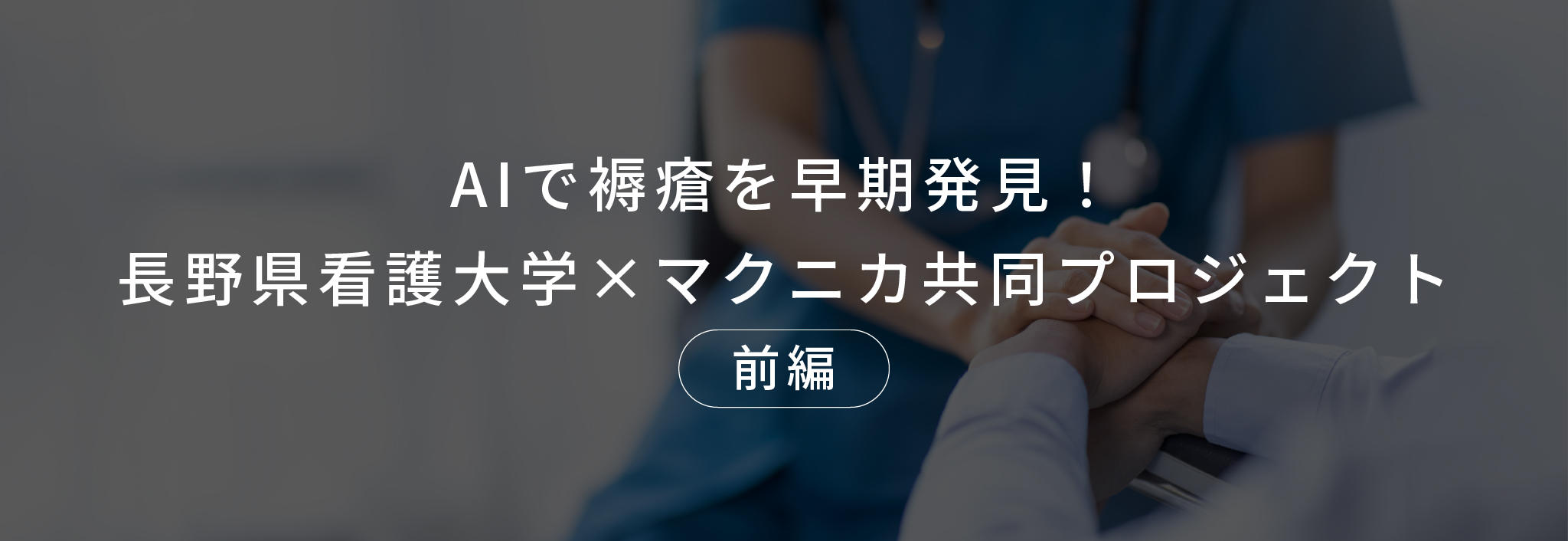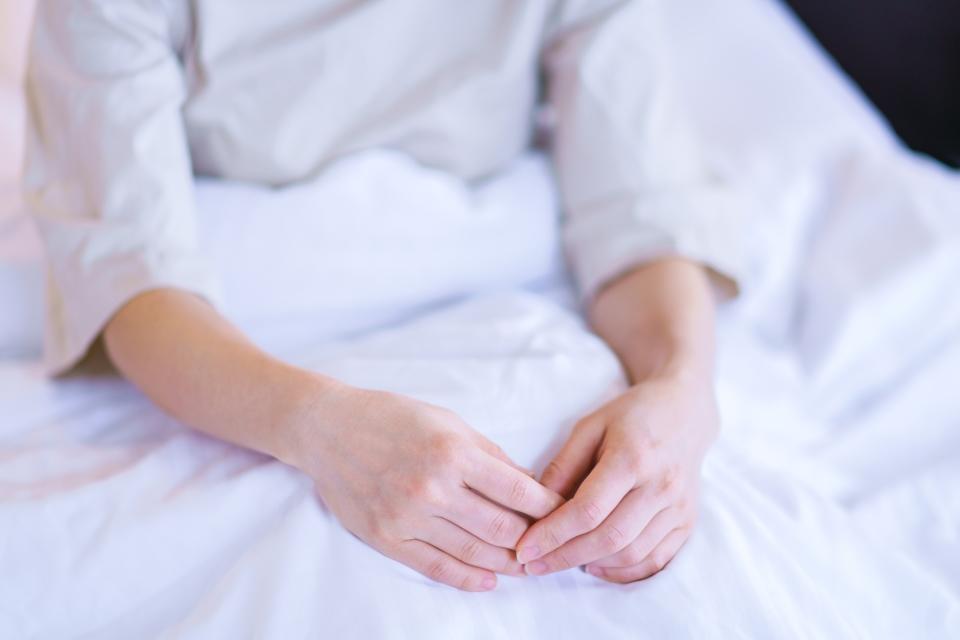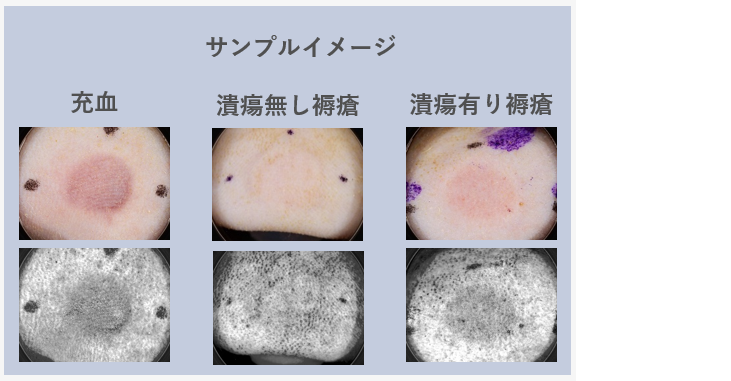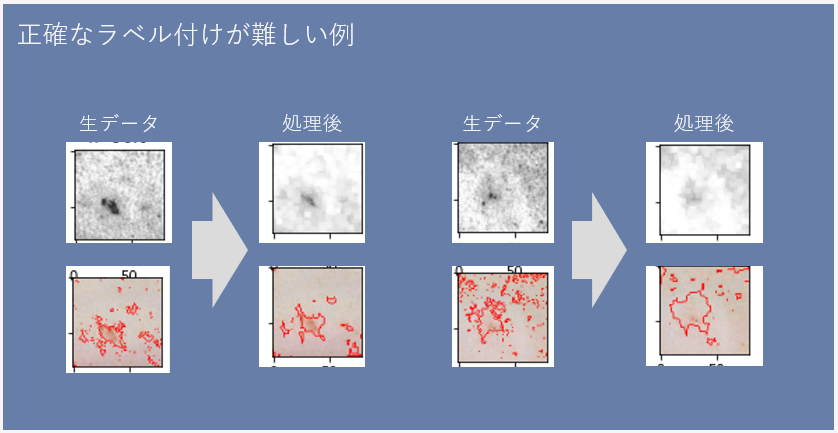
昨今の医療分野で問題視されている症状に、「褥瘡(じょくそう)」というものがあります。これは主にヒトの皮膚に悪影響を及ぼすことから、早期の治療が肝要とされています。そしてマクニカでは以前から、その研究に注力している長野県看護大学様と共同で、AIを活用したプロジェクトを推進しています。
今回は同プロジェクトの一員であるマクニカの榊原 麗(さかきばら うらら)が、その取り組みについて語ってくれました。
なお本記事は【前編】と【後編】に分かれており、それぞれ下記の内容が中心となっています。
【前編】:2022 年 6 月~2023 年 3 月までに取り組んだ「褥瘡早期発見 AI モデルの開発(PoC1)」
【後編】:アメリカで開催された NPIAP 2024 Annual Conference(米国褥瘡諮問委員会学会:以下、NPIAP2024 ※)での発表と、
2023 年 4 月~9 月までに取り組んだ「褥瘡早期発見 機械学習モデルの開発(PoC2)」
褥瘡の早期発見を目指した共同プロジェクトが始動
長野県看護大学様と私たちが共同で推進しているのは、褥瘡の早期発見ができるAIの開発プロジェクトです。褥瘡は長時間の寝たきり、車椅子に座ったままなどの影響で身体の一部が圧迫され続け、血流が悪くなることで皮膚が壊死したり、炎症を起こしたりするなどの痛みを伴う症状です。「床ずれ(とこずれ)」と呼ばれることもあります。
たとえば介護の現場では、数時間ごとに体勢を変えるなどの対策がとられています。しかし、当人が血流の悪化で痛みをあまり感じなかったり、外見は正常でも水面下で症状が進行していたりして、発見が遅れることもあるそうです。加齢などで免疫力が下がっている状態で身体の一部に圧力がかかり続けた場合、そのあとは除圧して放置しても、発症の可能性があるとも言われています。また、治療には長い時間がかかり、場合によっては手術も必要です。

長野県看護大学様では治療に向けた色々な研究のなかで、褥瘡の早期発見も目指しています。褥瘡悪化の予防や早期治療が実現すれば、結果的に患者さんの生活の質が向上し、医療費も軽減できるからです。そうした最終的なゴールに向け、今回のプロジェクトでは「除圧後24時間以内に褥瘡を発見すること」がひとつの目標になりました。
しかし、褥瘡の早期発見は難しい課題でした。たとえ肉眼によって表面上で確認できなくても、内部で症状が進んでいる可能性があるからです。そこで私たちは、「皮膚の状態を写した画像をAIに学習させることで、褥瘡の発症を予測できるようにしよう」と考えました。今回のプロジェクトでは長野県看護大学様のご協力のもと、ラットを対象に擬似的につくりだした褥瘡の画像データを用いました。
開発用データの収集と前処理
データ収集の過程ではいくつかの条件を変え、褥瘡発症の有無や状態の違いなど、さまざまなパターンを確認しました。たとえば、「○分経過時点で充血、○時間経過時点で潰瘍有り褥瘡」といった具合です。
具体的には、皮膚にかける圧力を強弱の2種類に分けました。まず、弱い方は45分間圧力をかけ、除圧後0~60分までの経過を観察。次に、強い方は3時間50分圧力をかけ、除圧後30分~120時間までの経過をそれぞれ観察しました。すると、圧力が強かった方は、除圧後に放置しても褥瘡が進行することが分かったのです。

▲「充血」は発赤が最終的に通常皮膚の色味に戻る、「潰瘍無し褥瘡」は皮膚ダメージがひどくない褥瘡、「潰瘍有り褥瘡」は皮膚ダメージが著しい褥瘡を示します。なお、外側の黒い点は圧力をかけた部位を見失わないためのマーキングです。

▲時間経過による皮膚の変化を肉眼で観察し、その結果を示した資料。最初の0.5時間と最後の96時間を比べると、明らかな差があります。
出典:Chen, L.; Yuan, Y.; Takashi, E.; Kamijo, A.; Liang, J.; Fan, J. Establishing an Appropriate Pressure for the Transparent Disc Method to Distinguish Early Pressure Injury and Blanchable Erythema. Diagnostics 2022, 12, 1075.
上図のケースは3時間50分のあいだ圧力をかけてから除圧し、その後放置した結果です。徐々にピンクの部分が濃くなって赤い点々が出現し、最終的には96時間で潰瘍ができていることが分かります。症状が進む条件などに違いこそあれど、人体でもこれと同様の症状が起こります。そして96時間後のような状態になると治療が難しくなるため、できれば12時間~18時間ぐらいのステージでの対処が望ましいというわけです。
こういった画像をAIモデルに学習させ、「この皮膚にはやがて褥瘡ができる」と正しく予測するには、十分な質と量のデータを確保しなければなりません。今回は多くの画像を用意することが難しく、画像の座標に生じていた微細なズレの調整などにもかなり苦労しましたが、色々な工夫で乗り切りました。
データ前処理の一例として、今回は画像のノイズ除去についてお話します。私たちは大学の先生方から「UV(紫外線)カメラを通した白黒の画像なら皮膚の表面だけでなく、内側の方まで見られるはず」と推奨いただき、対応したカメラで撮影した画像を使いました。実際、カラー写真の肌の色にはさまざまな色味が入ってくるため、画像にノイズが入りやすいことが課題でした。しかし、皮膚は見た目ほど均一ではないうえに、血流などの影響もあるため、白黒画像の方でも潰瘍とは関係のない点々が目立っていました。
「一定の黒さを超えている部分は潰瘍と見なす」という閾値の設定方法では、やはりノイズが多く残ってしまいますし、手動でのクロップはデータ処理にあまりにも時間がかかります。そこで、点々部分にぼかし処理を入れることにしました。すると、潰瘍の部分をある程度正確に捉えられるようになり、最終的に「この部分は潰瘍である」というラベルを高い精度で自動的に付与できるようになりました。

▲下段画像の赤い部分が、データ前処理によって潰瘍と自動付与したラベルです。処理をしていない生データの方では関係ない部分も多く含まれていますが、処理を加えることでノイズが減っていることが分かります。
オープンデータも活用した分析
今回は、既存の深層学習モデル「ResNet50」を使い、潰瘍がある画像と、ない画像の両方をAIに学習させました。「この皮膚のパターンでは、のちに褥瘡ができる」と正しく推論させるためです。そして学習の方針は、大きく2種類に分かれていました。
1つ目は、大規模画像データベース「ImageNet」の使用です。これは医療分野と無関係のデータベースでしたが、今回は確保できた画像の枚数が少なかったため、できるだけ精度を高める目的で採用し、そこから事前学習して得たモデルの重みを活用しました。
2つ目は、皮膚患部のオープンデータを使った事前学習を行うことです。オープンデータの内容は、褥瘡とは異なる皮膚病などの画像ではあるものの、「おそらく1つ目の方法よりも、こちらの方が学習効率や精度が高くなるだろう」というのが、私たちの考えでした。
また、それとは別に時点ごとや、UV(白黒)画像とLED(カラー)画像の学習・精度比較なども行っていました。本プロジェクトは「除圧後24時間以内の褥瘡発見」が目的のひとつであるため、複数の検体の同じ時間同士の画像比較からラベル付けを行うことで、早い時点でも正確な予測ができるように試行錯誤しました。
白黒画像の方が高精度という結果に
「オープンデータによる事前学習の有無」「画像はUV(白黒)か、LED(カラー)か」という条件の組み合わせで全4モデルのAI学習を行った結果、今回は「事前学習有り・UV画像」のモデルが高い推論精度を得ました。下のグラフでは、緑色の線と囲った部分が該当します。
▲3つのグラフは左から順番に、Accuracy(正解率)、Recall(再現率)、FNR(異常見逃し)を示しています。また、各グラフの縦軸はそれぞれの指標、横軸は経過時間です。
左側と真ん中のグラフではまんべんなく高いモデルがあればよかったのですが、時点ごとに精度のバラつきがあるため、ある程度は折れ線の上下が見られました。ただ、「事前学習有り・UV画像」は、早い時点でも精度が大きく下がらなかったことが特徴のひとつです。
今回のプロジェクトで私たちが特に重視していたのは、真ん中の「Recall(再現率)」でした。このスコアは「画像に対して、潰瘍があると網羅的に推論できたかどうか」を示しており、高ければ高いほど、あるはずの症状を“ない”と誤診するリスクが低減します。これは、医療の分野において非常に重要なことです。
こちらは「96時間後、潰瘍が表れそうな部分はどこか?」をAIモデルを使って予測し、その内容をヒートマップで示した画像です。左側の除圧6時間後の時点では、どこに潰瘍が表れるかの予測は人間には難しいですが、画像で学習したAIモデルはその箇所を確実に捉えていました。
▲ヒートマップの赤色が濃い部分は潰瘍ができる可能性が高く、青い部分は低いことを示しています。
AIの学習には「潰瘍あり褥瘡」の画像だけを使用していたのですが、褥瘡と間違えないかどうかを検証するために、充血(発赤があるものの、時間経過で元の皮膚色に戻る状態)のデータも収集していました。結果、時点によって推論精度にバラつきは見られたものの、最終的には、除圧10分後の画像における推論精度が高いことが分かりました。充血は潰瘍と違って除圧すると色味が薄くなるので、時間が経てば経つほどに推論が容易になることが特徴だったと言えます。
まとめ
今回は、一見すると潰瘍ができると分かりづらい皮膚の状態でも、その後の経過を的確に推論できるモデルを開発できたことが収穫でした。また、今回のプロジェクトでは長野県看護大学様と共創できたことで、ソーシャルグッドをより強く意識して取り組めました。褥瘡がどれほど問題視されているかは、まだあまり表面化していないことだと思いますが、AIはこうした課題の解決や人助けに役立てることができますし、そのために私たちはさまざまなプロダクトの開発を進めています。